Life After Football: The Art of Watching Game Film
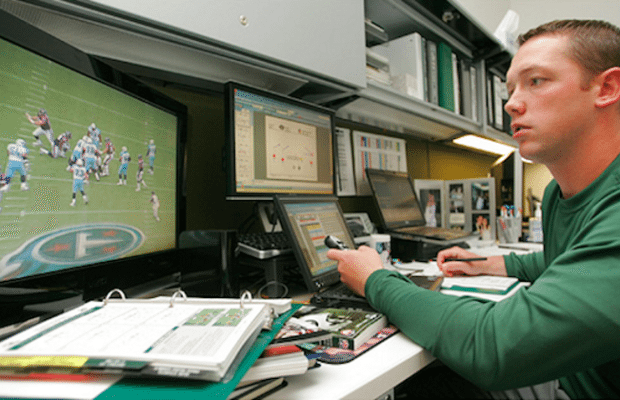
Whether you are a player or a coach, you have to study game film. Former coach and now author, Alex Kirby, offers some valuable insight into the proper ways to break down and analyze game film.
I often get asked what my “process” is for breaking down game film. My initial response is usually to say that I don’t have one, and I’m not sure that I do anything complex that couldn’t be done after a long time of watching and analyzing film.
Since I’m out of coaching these days and am now writing books instead, I use different techniques than you might, but that’s what I’ll be talking about today.

I don’t have an original and fool-proof way of breaking down film that I developed on my own. Almost everything I do I learned and borrowed from someone else, and found a way to add to what I do.
Hopefully you’re able to do the same, to take one or two things from what I’m writing about today and make yourself better.
I should add that if you’re a young coach who is looking to learn more about the game, you won’t be able to do that by doing your weekly breakdowns of each opponent during the season and then never watching video again until it’s time to prepare for week one the next fall. Good coaches are always looking to get better, and that means spending extra time in the offseason to learn about the newest trends in football, and especially what your opponent is doing.
You may say, “I just don’t want to put that much time in.”
That’s fine, just don’t complain when you’re not rewarded with more responsibility in your coaching career.
If you’re someone who doesn’t want to put all that time in, just stop reading right now, because this isn’t for you.
If you’re still interested in learning more, and want to make yourself better, let’s get started.
The Basics
In my experience, there are two different approaches to watching football game film:
- Breaking down game film
- Analyzing game film
There is the breakdown method of watching film, where you’re going through each play and tagging all the different formations, motions, blitzes, coverages, and any number of other variables that you want to track.
That’s not what I’ll be talking about in this post, but if you want a tremendous guide on how to attack that problem, I suggest you click here and scroll down to the bottom of the page to download (completely free) Mike Stoeber’s excellent book on game breakdowns.
The other approach is what I’ll be referring to as analysis, which is a much more useful for the kind of work I do.
What that means is that I’m attempting to figure out not just what happened, but why. The actual plays aren’t as interesting to me as how the whole scheme fits together, and what coaches will turn to when their backs are against the wall.
Below are some examples of the questions you should be asking when analyzing a game from start to finish:
Situation – Nothing in football happens in a vacuum, everything is context, especially when you’re analyzing plays that happen later on in the game
Why did a coach call that play? Why did that defender react the way he did? Etc…
When it comes to this method of watching film, the reasons why a play was called are just as important as the actual mechanics of the play itself.
Personnel – How are the offense and defense moving their best players around to create uncertainty, or are they lining up in the same spot every play in the name of consistency and simplicity?
When they do move around, what’s the reason for it? If it’s an offensive skill player, are they trying to get him open, or just trying to see how the defense will adjust? If it’s a defender in the front, is he following the tight end strength, or is it a field/boundary call?
What Worked/ Didn’t Work Last Time – This is especially helpful the further you go into a game.
At the beginning of the game, most offensive coaches want to throw a bunch of different looks at their opponent to get them thinking about how many different things there are to defend. As the game goes on, a good coach will make subtle changes and run constraint plays based off of what works and what doesn’t.
Alignments and Fronts – Football is about numbers, but it’s also about leverage.
There are countless ways to line up in a 3×1 set, and many different variations out of each of those on how line up the back in the backfield to put added stress on a defense.
Defensive coordinators will have (or should have) general rules in place for their guys on how to line up against these different looks, and the offense should attempt to figure out what they are and respond accordingly.
This rule also applies to the fronts the defense lines up in as well. What is their objective in lining up this way? Who do they have on the field and what are they most concerned about stopping? How does the offense react?
Now that we’ve gone over a few of the questions I use when analyzing film, let’s go to another important step…
Draw it Up
When you’re drawing 22 men on the field and where they’re lining up in relation to one another, it forces you to pay attention to details all across the field like spacing, depth, and how certain players react after the snap.
You can get as detailed as you like with this, and in my experience, the more detailed the better.
I’ll take a wide ruled notebook or legal pad and begin to draw up the play after I’ve written the down, distance, and yard line situation at the top of the page to give some context to what it is I’m drawing up. If I’m working on a project breaking down a single drive or an entire game, I’ll also be sure to note what drive and what play of the drive it is as well.
I go out of my way to say “wide ruled” because the lines on the paper are very important to how the drawing is put together, and they help me space everyone out appropriately, because I treat each line on the paper as equivalent to a five-yard marker.
This kind of landmark within the diagrams assures that the spacing and depth, especially of the men on the defensive side of the ball, will be a lot more accurate and proportionate than if I was drawing these plays up on a piece of blank white paper.
When breaking down college film, I also go out of my way to draw up hashmarks in the proper places behind the offense so that the field is appropriately spaced out.
I don’t do this when watching NFL tape, since the hash marks are so much closer together that the offense starts each play in the middle of the field, regardless of how far to the right or the left they are.
I also don’t mark where the numbers are, or mark where the sideline is. I don’t have any reason for this other than it just seems like overkill to me, but there’s no reason you couldn’t do it if you wanted to take it that far.
Taking notes
This is the part that I treat like a brainstorming session based on what I see on the screen, and what I’m thinking about at that time.
I like to write everything I’m thinking, no matter how ridiculous it may seem at first, and even if I don’t even believe it. If someone came along and tried to read what I wrote, it would look pretty disorganized, because I don’t organize the words underneath the diagrams into neat and convenient bullet points.
The reason I want to write out as much of my internal monologue as possible is because there’s a good chance that the conclusions I come to right away are the wrong ones, or at least need to be adjusted. I could come back to this same diagram and notes several days, maybe even weeks later, and if all I have are the finished bullet points of a wrong conclusion, I don’t have any way to recapture my original train of thought.
So let’s take a look at a real life example:
The next couple of plays are taken from my notes on the Auburn-Louisville game from the first week of the season. I’m planning on doing a project on this game later on, so I’ve got some notes laying around that I thought would be a good demonstration.
These are what I wrote down, completely unedited, for a couple of early plays in the game.
Auburn Drive 1 / Play 2
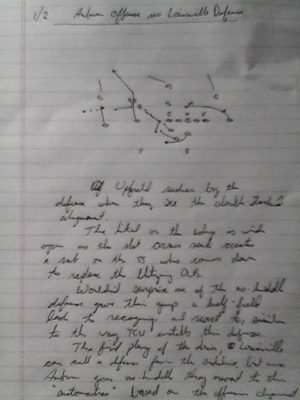
Upfield rusher by the defense when they see the double-stacked alignment.
The hitch on the edge is wide open as the slot corner route creates a rub on the SS who comes down to replace the blitzing OLB.
Wouldn’t surprise me if the no-huddle defense gave their guys a half-field look to recognize and react to, similar to the way TCU installs their defense.
The first play of the drive, Louisville can call a defense from the sideline, but once Auburn goes no-huddle they revert to their “automatics” based on their offensive linemen.
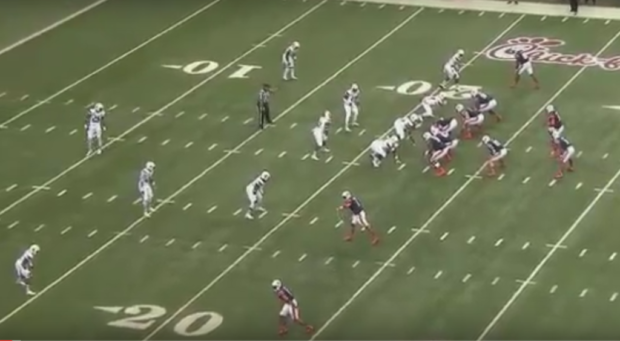
Auburn Drive 1 / Play 3
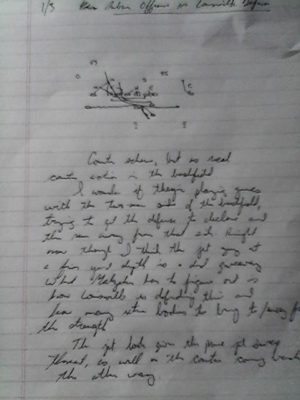
Counter scheme, but no real counter action in the backfield. I wonder if they’re playing games with the two-man side of the backfield, trying to get the defense to declare and then run away from that side. Right now though I think the jet guy at a five yard depth is a dead giveaway. What Malzahn has to figure out is how Louisville is defending this and how many extra bodies to bring to/ away from the strength.
The jet look gives the prime jet sweep threat, as well as the counter coming back the other way.
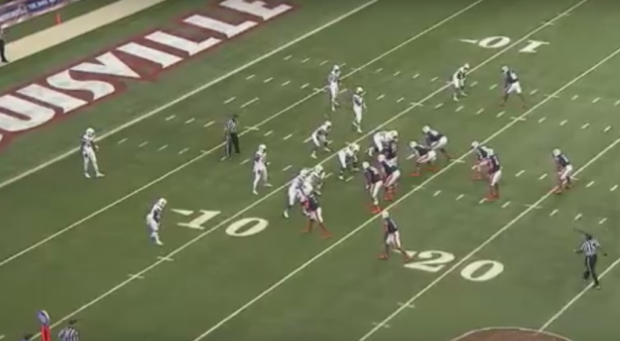
The actual process is pretty simple, it’s just a matter of how detailed you want to get with it. I can also say from experience that doing an entire game in this style is something that can take you a while, and it’s probably not practical for doing in-season if you’re on a tight schedule that coaches have to deal with.
The important thing is not how complex your process is, it’s about whether or not you have a process that works for you. This is one thing that works for me, but that doesn’t mean that I won’t find something better tomorrow that I can add to it. It’s all about learning and getting better every day.
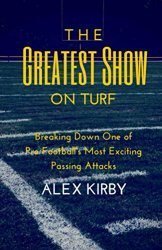
Short of a one-on-one clinic, there’s no better way to learn the nuts and bolts of a scheme, and it’s one of the ways I put together my latest book: The Greatest Show on Turf